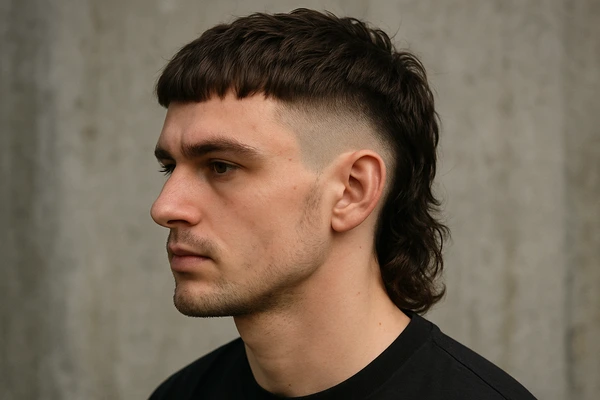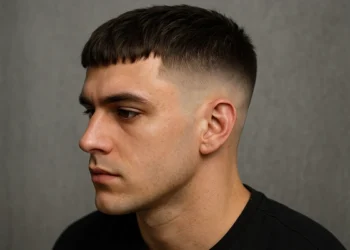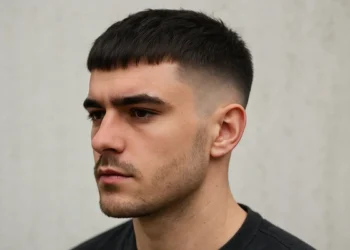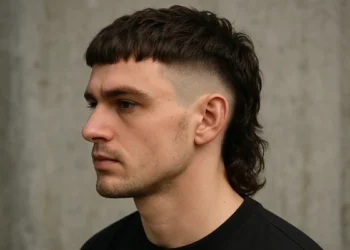The French crop mullet is a creative twist that blends two iconic styles—the short, clean look of the French crop and the edgy flair of a mullet. Perfect for modern men and trendsetters, this hairstyle suits a variety of hair textures and face shapes. Whether you prefer a textured French crop mullet or want to try it with curly or straight hair, this cut delivers personality and style. In this blog post, we’ll break down what the French crop mullet is, why it works, who it suits best, and how to style and maintain it. Plus, we’ll explore key variations like the French crop top mullet and adaptations for different hair types.
What Is a French Crop Mullet?
A French crop mullet haircut is a hybrid style that fuses the sharp front fringe of the French crop with the longer back of the mullet. It balances structure and rebellion—short on the sides and front, longer at the back, creating a contrast that’s modern and fashionable.
- French Crop: Characterized by a blunt fringe and short sides, often faded or tapered.
- Mullet: Known for its “business in the front, party in the back” design with longer length at the nape.
Combining these gives a style that is both tidy and wild—perfect for those wanting a standout yet wearable look.
Why the French Crop Mullet Is Trending
This style has gained popularity thanks to its:
- Versatility: Can be adapted to different face shapes and hair types (curly, straight, or wavy).
- Unique Appeal: Mixes classic and contemporary vibes.
- Low Maintenance: Easy to style once cut properly.
- Celebrity Endorsement: Seen on influencers and fashion-forward celebs, driving demand.
It appeals to those who want a look that’s both structured and expressive—ideal for those who like experimenting without going overboard.
French Crop Mullet for Different Hair Types
1. French Crop Mullet Curly Hair
For guys with curly hair, this style enhances natural volume and texture. The curls add movement to the mullet section while the cropped front keeps things neat.

Tips:
- Use curl-defining cream to shape the mullet.
- Keep the sides short to balance the volume at the back.
This version is especially flattering for oval and round faces as it elongates the appearance of the head.
Explore: Curly French Crop Haircut
2. French Crop Mullet Straight Hair
With straight hair, the French crop mullet has a sharper and more dramatic silhouette. The clean fringe and longer back give a bold contrast that looks sleek and edgy.
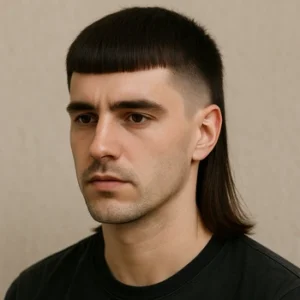
Tips:
- Use matte clay or pomade for styling.
- You can add some choppiness or texture with a razor for a textured French crop mullet effect.
Straight-haired individuals can easily showcase the shape and structure of this style.
Read Also: French Crop Straight Hair
Variations of the French Crop Mullet
A. Textured French Crop Mullet
Adding texture makes this style more modern and relaxed. It involves layering the top and mullet section using point-cutting or razoring.

- Ideal for medium to thick hair.
- Works well with wavy hair types too.
- Texture softens the look and adds movement.
This version looks effortless and is great for casual and semi-formal looks.
Read Also: Textured French Crop
B. French Crop Top Mullet
The French crop top mullet emphasizes volume on the crown or upper top section, often combined with a slight pompadour or disconnection from the fringe.
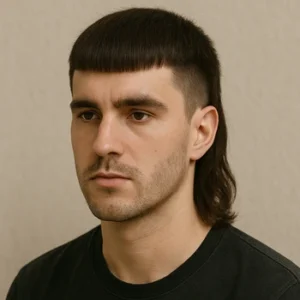
- Adds height to the style.
- Suitable for diamond or round face shapes.
- Can be paired with skin fade or low taper on the sides.
This version is edgier and more street-style inspired.
Who Should Try a French Crop Mullet?
This style suits a wide variety of people, but it’s especially great for:
- Creative professionals or students looking to express themselves.
- Men with oval, square, or heart-shaped faces.
- Those who want a modern alternative to the classic mullet or Caesar cut.
- People willing to visit the barber every 3–5 weeks for upkeep.
It might not be the best choice for very thin or fine hair unless texturizing products or styling tricks are used.
How to Style a French Crop Mullet
Styling the French crop mullet can be quick and fun. Here’s a basic routine depending on hair type:
For Straight Hair:
- Blow-dry the fringe forward and the back down.
- Use lightweight styling wax or pomade.
- Optional: Add volume to the crown for the crop top effect.
For Curly Hair:
- Use curl-enhancing products while hair is damp.
- Let hair air-dry or use a diffuser.
- Define curls in the mullet using your fingers.
For Textured Looks:
- Use sea salt spray before blow-drying.
- Scrunch the hair or tousle with your fingers for a laid-back finish.
Keeping the fringe trimmed is key, and the mullet length can be customized based on your lifestyle or fashion goals.
Barber Tips for Getting It Right
- Communicate clearly with your barber—bring a reference photo.
- Decide on the length for each section (top, fringe, sides, and back).
- Choose the side detailing: fade, taper, or undercut?
- Ask about texture customization to suit your hair density and growth pattern.
If you’re not sure how dramatic you want the mullet to be, start subtle and go bolder over time.
Maintenance and Care
The French crop mullet is relatively low maintenance but requires some attention:
- Trimming frequency: Every 3–5 weeks.
- Styling time: 5–10 minutes daily, depending on texture.
- Products needed: Texture spray, wax or pomade, and a comb or diffuser.
Keep the fringe shaped and avoid letting the back become too unruly unless going for a retro mullet vibe.
Final Thoughts
The French crop mullet haircut is perfect if you want to stand out with a hairstyle that’s equal parts bold, refined, and playful. It suits both curly and straight hair, works for different lifestyles, and offers plenty of customization options. Whether you like a textured look, a crop top mullet, or a more classic version, this haircut lets you experiment with edge and tradition all at once.
If you’re ready to step into a style that turns heads while being surprisingly easy to manage, the French crop mullet might be your next signature cut.
